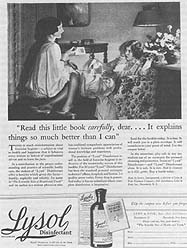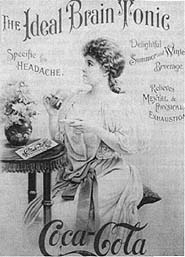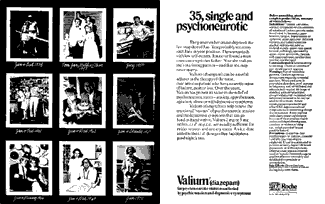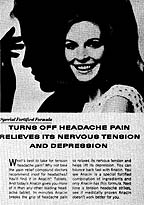|
Source: Stay Free! http://ibiblio.org/stayfree/ ; Issue 16, Carrie McLaren
One of the most successful advertising campaigns this century sold perhaps the most unlikely product: yeast. Once a household staple, yeast sales had been dying in the 1910s due to the decline of home baking. Yeast leader Fleischmann’s responded by attempting to transform the "Soul of Bread" into a more lucrative form of edible dust. A new advertising campaign pitched yeast as a source of vitamins to be eaten straight from the pack.
When the vitamin idea didn’t go so well, the ads turned to trumpeting Fleishman’s as a cure for constipation. A cake and a half three times a day were said to combat "intestinal fatigue."
Yeast had no proven laxative effect, and "intestinal fatigue" was pure invention, but sales more than doubled. As one ad exec explained, "Fatigue is universal; we simply have to credit it to the intestines."

|
|
In the 1920s, advertising for Lysol disinfectant started subtly suggesting that it could be used as a contraceptive. Lysol offered booklets explaining "What feminine hygiene really is" for those not astute enough to realize that the repeated claims to "kill germs" were meant to be read as "kill sperm." (R. Marchand, Advertising the American Dream p.344) Click image for larger version.
|
|
Fleischmann’s hardly invented the bogus medical claim, but, unlike most corporate advertisers at the time, they weren’t ashamed to adopt the tactics of patent medicine salesmen. Said peddlers established just about every key advertising strategy in the 1800s. Gratuitous use of statistics, claims to science, "used by doctors," testimonials, celebrity endorsements, appeals to patriotism, nature, and politics: all were honed on cure-alls.
Why medicine and not, say, breath mints? Medicine was essentially the first product where supply exceeded demand. Formulas were cheap and practically interchangeable (unless one developed a strong preference for the opium or cocaine in some). People bought potions not for what they contained but for what they treated. Thus, salesmen were limited only by the number of ills they could find, which is to say they weren’t limited. If one pitch didn’t work, they could always reposition.
When Fleishmann’s started using the old sales tactics, other corporate advertisers did, too. Listerine, formerly a surgical antiseptic, a dandruff cleanser, sore throat treatment, and a guard against Asian flu, became a cure for bad breath when its ad agency decided one was needed. The ad campaign launched halitosis–the disease of bad breath–and sales skyrocketed. What Listerine did for halitosis, Absorbine Jr. did for athlete’s foot. (Absorbine Jr. previously treated sore muscles and insect bites.) And the list goes on. Lifebuoy soap gave the world "B.O."; Phillips Milk of Magnesia, "acid indigestion"; and the discovery of vitamins popularized scurvy and led many advertisers to refer to ever-rampant "vitamin-starvation."
The scare tactics common then have for the most part disappeared. Ads now purport to make people feel good rather than anxious; the incessant chirping of pharmaceutical commercials nearly manages to make even "nausea," "headache," and "certain sexual side effects" sound upbeat. Yet a classic conflict of interest remains: Advertising sells both ills and their cures, giddily blurring the lines between medicine, nutrition, and hygiene.
In a sense, health is like everything else associated with the needs or wants purchaseable through advertising. Like the amounts of food, clothing, and shelter deemed necessary, "good health" is fluid, varying across cultures and over time. Toothpaste was considered a luxury item in the 1920s. Body fat can be a sign of either health of sickness, depending on the era.
|

|
|
Coca-cola was originally sold as a patent medicine, a brain tonic.
|
|
Given the central role of the market in American culture, it’s no surprise that the market has a great deal to do with what we consider healthy and not. Fifteen years ago, depression meant sadness: getting dumped or losing your job. Now it’s something you’re born with. The availability of a drug changed how we defined the problem.
Just as it did back in the day, advertising still aims to define both ill and cure–only the drugs are no longer inert. And thanks to ever-receding FDA regulations, drug marketers have a powerful new tool in direct-to-consumer advertising, particularly TV commercials. Drug commercials, so the reasoning goes, are needed to educate consumers of available options–a curious argument considering that, even when given the chance, drug advertisers do just about everything they can to avoid discussing the problem and the product. A quick run through the dial shows most drug ads going for the educational punch of an old Hallmark commercial.
As drug companies continue to push the envelope on what’s permissible, advertising is likely to have an even greater role in shaping cultural notions of illness. For example, when it comes to advertising, the more symptons–and the more noticeable, painful, and embarrasing the symptoms–the better, because the easier it is to sell to consumers; that is, the more likely the illness will be self-diagnosed. And drugs for self-diagnosed ills–allergies, weight-reduction rather than cholesterol or blood pressure–are those seeing the greatest boost from commercials. Eskimos may have 14 words for snow, but we’ve now got just as many for allergy symptoms. In the same way that the availability of a drug such as Prozac can define an illness, televisibility now figures in.
|
|
As fluid as good health is, there is a constant that spans time and culture: the placebo effect. Believing in a treatment helps. Needs and wants are fluid precisely because physical health is intricately tied with the emotional. Headache remedies provide temporary relief from agonizing coworkers; baldness drugs combat low self-esteem. It’s no real shocker, then, that a new batch of prescription drug ads could just as well be ads for cars, jeans, or carbonated beverages. Pills, like goods, aren’t sold for their physical properties–obscure chemical names and compounds–any more than jeans are sold for rivets, or colas for carbonation. Coke adds life, Think Different, etc. Just mentioning something as mundane as hemlines in an ad can be a real downer; people are more interested in turning work into play, developing satisfying relationships, and getting laid.
|

|
|
A 1970 ad for Valium directed to doctors treating "unmarrieds with low self-esteem." Click image for larger version.
|
|

|
|
To cash in on the success of tranquilizers, over-the-counter pain relievers such as Anacin started promoting their analgesics as mood changers and antidepressants.
|
|
It is, in other words, eerily fitting for drugs to be sold as consumer products, for products–whether cookies, diet drinks, or cigarettes–have long been sold as drugs, as magical cures. One would be hard-pressed to find a more glaring example of this in action than Snackwells' commercials ("At Snackwell’s we like to think that snacking shouldn’t be about feeding yourself, but feeding your self-esteem."). The jaw-dropping inanity of its claim is matched only by the fact that the same basic strategies for selling health have managed to survive for centuries.
Just like knowledge, art, music, and love, health is packaged to be consumed. Hyper kids once needed strict parents (and perhaps a severe beating), now they get a dose of Ritalin. Seeing the doctor doesn’t really count unless you come away with medicine. Even when feeling good, credit goes to pre-emptive dosing, the stuff you take to avoid getting sick.
Consuming, in other words, is our placebo. Consuming and advertising provide easy temporary solutions to whatever ails. While any true understanding of health should include ways of dealing with and accepting illness, to every problem is promised an ad-like quick fix.
There is another way of looking at placebos, however. Once you can glimpse some company making ridiculous claims about yeast and intestines, or cookies and self-esteem, once you realize that something that’s just sugar, flour, and water can make you feel better, it’s clear that the solution to many ills, however mysterious, already resides within us.
|
|